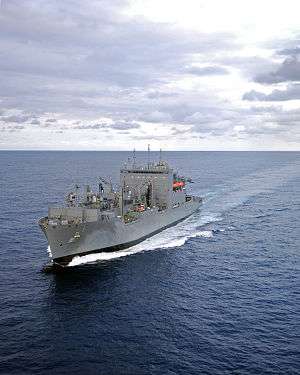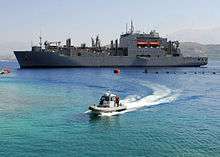USNS Lewis and Clark (T-AKE-1)
USNS Lewis and Clark (T-AKE-1) is an American dry cargo ship, the lead ship of her namesake class. It was the second ship of the United States Navy to be named for the explorers Meriwether Lewis and William Clark. The contract to build her was awarded to National Steel and Shipbuilding Company (NASSCO) of San Diego, California, on 18 October 2001 and her keel was laid down on 22 April 2004. She was launched on 21 May 2005, co-sponsored by Jane Lewis Sale Henley and Lisa Clark, descendants of the ship's namesakes. She was delivered to the Navy on 20 June 2006.
 USNS Lewis and Clark in the Atlantic Ocean, December 2006 | |
| History | |
|---|---|
| Name: | USNS Lewis and Clark |
| Namesake: | Meriwether Lewis and William Clark |
| Ordered: | 18 October 2001 |
| Builder: | National Steel and Shipbuilding |
| Laid down: | 23 March 2004 |
| Launched: | 21 May 2005 |
| In service: | 20 June 2006 |
| Identification: |
|
| Status: | in active service |
| General characteristics | |
| Class and type: | Lewis and Clark-class cargo ship |
| Displacement: | 41,000 tons (41,700 t) |
| Length: | 689 ft (210 m) |
| Beam: | 105.6 ft (32.2 m) |
| Draft: | 29.9 ft (9.1 m) |
| Propulsion: | Integrated propulsion and ship service electrical system, with generation at 6.6 kV by FM/MAN B&W diesel generators; one fixed pitch propeller; bow thruster |
| Speed: | 20 knots (37 km/h) |
| Range: |
|
| Capacity: |
|
| Complement: | 13 military, 123 civilian |
| Aircraft carried: | two helicopters |
Description

The T-AKE is a replenishment naval vessel operated by Military Sealift Command with civilian mariner crews (53 personnel) augmented by a military department (5 personnel). In 2012, Lewis and Clark became one of 14 ships that comprise the United States Marine Corps (USMC) Maritime Prepositioning Program (MPP).
Within days of her transfer to Maritime Prepositioning Squadron Two (MPSRON-2) in Diego Garcia, she participated in Exercise Coconut Grove in the Republic of the Maldives. Coconut Grove is a bilateral military exercise between the USMC and the Maldives National Defence Force (MNDF). This exercise was the inaugural exercise of this type vessel for the USMC MPP.
United States Marine Corps Forces, Pacific (MARFORPAC) conducted a proof of concept for operational employment of the T-AKE vessel in October 2012 during exercise Coconut Grove 12. Coconut Grove is a bi-lateral exercise conducted bi-annually with the MNDF.[1] This was the inaugural exercise using a USMC Maritime Prepositioning Force (MPF) T-AKE vessel and the first step in showing operational usage of MPF in support of ground forces ashore. Coconut Grove 12 provided an opportunity to test T-AKE concepts, and to continue development of doctrine and tactics, techniques, and procedures for the USMC use of this class of ship in this role.
On 29 September 2012, 98 Marines boarded a plane in Southern California bound for the Lewis and Clark located 9,547 miles away in the Indian Ocean. She loaded sustainment stocks just 40 days before at Blount Island Command in Jacksonville, Florida and ammunition stocks at Charleston, South Carolina. She completed her transit of 33 days and arrived on station one day prior to embarking Marines and sailing the additional 450 nautical miles to the exercise location in Gan, Maldives. Upon arrival, the exercise force offloaded its personnel and equipment, including four High Mobility Multipurpose Wheeled Vehicle (HMMWVs), using a contracted commercial barge to move personnel and equipment approximately one mile from ship to shore. Over the course of the ten-day exercise, the Marines ashore and afloat received 100% of their sustainment from stocks loaded aboard the USNS Lewis and Clark. This marked the first time an entire exercise force, its equipment (including rolling stock) and its sustainment were supplied from a Military Sealift Command (MSC) vessel of any kind. The lessons learned during this inaugural operational employment of the T-AKE validated the operational viability of this type vessel to support ground forces ashore and will be further refined in future exercises.
Without USNS Lewis and Clark's participation, this exercise would have been just another routine exercise event in the Pacific Ocean by the United States Marine Corps. In the end, USNS Lewis and Clark's role and the validation of operational employment of the T-AKE vessel was just as important as the engagement and training activities conducted by the company of Marines ashore.[2]
Features
The USNS Lewis and Clark helps allow the Marine Corps maintain a forward presence. Her primary mission is the delivery of supplies to enable the arrival and assembly of a Marine Expeditionary Brigade (MEB). The T-AKE transfers cargo — ammunition, food, fuel, repair parts, ship store items and expendable supplies to Marine and joint forces ashore.
This ship was featured in the History Channel's Modern Marvels episode on copper.
Background
The Navy awarded National Steel and Shipbuilding Company of San Diego, Calif., a $406.9 million competitive contract 18 October 2001, to build the first ship of the class, USNS Lewis, and Clark. The Navy also exercised a $301.6 million option in the contract for the construction of the second ship of the class, USNS Sacagawea.
The U.S. Navy had previously fielded a ballistic missile submarine named USS Lewis and Clark (SSBN-644).
Deployment
_is_underway_in_the_Arabian_Sea.jpg)
In February 2009, the ship was deployed off the coast of Somalia as part of Operation Enduring Freedom - Horn of Africa. The vessel was fitted out to be used as a prison ship for captured pirates until they could be extradited to Kenya for trials. Sixteen pirates have so far been sent to Lewis and Clark after being captured in two different actions by the USS Vella Gulf.[3] On 6 May 2009, Lewis and Clark was approached by suspected pirates off the eastern coast of Somalia and took evasive action to prevent a successful attack. Suspected pirates then fired small arms weapons from approximately two nautical miles toward Lewis and Clark, which fell one nautical mile short of the ship's stern. Lewis and Clark continued to increase speed, and the skiffs ceased their pursuit of the U.S. ship.[4][5] On 20 November 2010, the Lewis and Clark responded to a distress call by the Chinese-flagged cargo ship M/V Tai An Kou which was under attack by Somalian pirates in a dhow and two skiffs. The crew on the Chinese vessel had secured themselves in a safe room by the time the Lewis and Clark arrived on the scene. Upon sighting the US naval vessel, the pirates opened fire on her and the Lewis and Clark returned fire in a brief engagement that drove the pirates off without causing any casualties. The destroyer USS Winston Churchill then also arrived on the scene 10 hours later and launched a helicopter to provide additional assistance until the PLAN frigate Xuzhou arrived.[7]
Honors and awards
The USNS Lewis and Clark is authorized the following awards:[8]
References
- Ramirez, L.Cpl Isis (5 October 2012). "CLR-17, T-AKE-1 test mission, logistical capabilities". Defense Visual Information Distribution Service. Retrieved 30 May 2013.
- Barber, Major Robert G. (June 2013). "Open For Business: Operational Employment of the MPF". Marine Corps Gazette. 97: 23–26. Retrieved 30 May 2013.
- Pessin, Al (12 February 2009). "US Navy Captures More Pirates, May Take Them to Kenya". VOA News. Archived from the original on 15 February 2009. Retrieved 13 February 2009.
- "Navy ship outruns pirates, officials say". CNN World. 7 May 2009. Retrieved 12 February 2019.
- Cawthorne, Andrew (7 May 2009). "Somali pirates take Dutch boat, chase US supply ship". NewsDaily.com. Archived from the original on 9 May 2009. Retrieved 12 February 2019.
- "Combined Maritime Forces Responds To Suspected Pirate Attack". Defense Visual Information Distribution Service. 20 November 2010. Retrieved 12 February 2019.
- "Lewis and Clark". Navy Department Awards Web Service. Archived from the original on 15 May 2015. Retrieved 24 March 2016.
- This article includes information collected from the Naval Vessel Register, which, as a U.S. government publication, is in the public domain. The entry can be found here.
External links
| Wikimedia Commons has media related to IMO 9271418. |